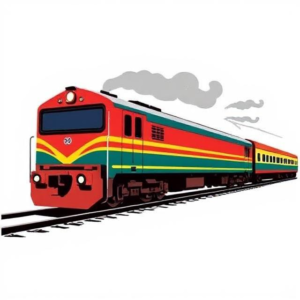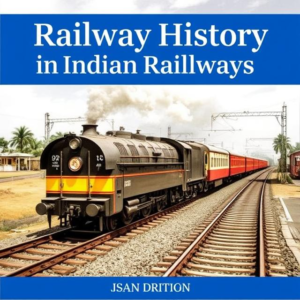Indian Railways has a long and fascinating history that spans over 170 years, transforming the transportation system of India. Let’s break it down simply:
Early Beginnings (Pre-Independence Era)
- First Train in India (1853): The journey of Indian Railways began on April 16, 1853, when the first passenger train ran from Mumbai (then Bombay) to Thane, covering a distance of just 34 km. It was a significant event, with a crowd of 400 passengers onboard. This marked the birth of India’s first railway network.
- British Influence: The British government played a crucial role in the development of railways in India. They built railways mainly for transporting goods (like coal, cotton, and other raw materials) and for moving troops across the vast country. This helped in linking various parts of India, making it easier to control and exploit resources.
- Railway Expansion (1850s – 1900s): By the late 1800s, railways had spread across India. The first major railway lines connected Mumbai to Calcutta (now Kolkata), and Delhi to Mumbai, transforming the landscape of travel and trade.

The Golden Age of Railways (Early to Mid 20th Century)
- Growth of Railway Networks: Over time, the railway system grew rapidly. By the time India gained independence in 1947, India had one of the largest railway networks in the world.
- Introduction of Major Railways: Different regions had their own railway companies. Some important railway zones were established like:
- The Great Indian Peninsula Railway (GIPR)
- The East Indian Railway (EIR)
- The Madras Railway (MR)
- Train Services for Public: In addition to goods transportation, the railways started offering passenger services. Special luxury trains were introduced for the elites, like the Palace on Wheels (introduced in the 1920s), designed to offer royal travel experiences.
Post-Independence Era (1947 – Present)
- Nationalization (1951): After India gained independence in 1947, all the private railway companies were taken over by the government and merged into a single entity – Indian Railways. In 1951, the Indian Railways Corporation was formed to manage this huge system.
- Technological Advancements:
- Electrification (1950s-60s): Electric trains started replacing steam-powered ones in many areas, reducing pollution and making the railways more efficient.
- Fast Trains: The introduction of Rajdhani Express (1969), one of India’s fastest trains, provided faster travel between major cities like Delhi and Kolkata.
- Suburban Services: Cities like Mumbai, Chennai, and Kolkata also developed suburban train networks to cater to the daily commuters.
- Modernization (1980s – 2000s): In the 1980s and 1990s, Indian Railways underwent modernization:
- Introduction of New Train Types: Trains like Shatabdi Express (1988) and Duronto Express (2009) were introduced for faster and more comfortable travel.
- Computerization of Ticketing: The introduction of computerized ticket booking systems made train travel more accessible and efficient.
21st Century and Recent Developments
- High-Speed Trains: Indian Railways has taken steps to introduce bullet trains, starting with the Mumbai-Ahmedabad corridor, a project in collaboration with Japan. This is a big leap in making Indian Railways more modern and competitive.
- New Train Classes: To improve services, Indian Railways introduced premium trains like the Tejas Express (luxury trains) and Vande Bharat Express (semi-high-speed trains) for quicker, comfortable, and cleaner travel.
- Dedicated Freight Corridors: The government has worked on dedicated freight corridors to improve the speed and efficiency of goods transport, reducing the load on passenger trains.
Current Structure
Today, Indian Railways is the world’s fourth-largest rail network by size, and it is also one of the busiest. The railways are divided into 18 zones across the country, with thousands of stations serving millions of passengers daily.
Key Achievements:
- Largest Employer in India: Indian Railways is the largest employer in India, providing jobs to over 1.3 million people.
- Cultural Impact: The Indian Railways has become a symbol of India’s diverse culture, offering people from all walks of life a means of transportation. Trains, stations, and stories related to the railways hold a significant place in Indian popular culture.
Challenges and Future
- Modernization Needs: Despite major improvements, there is a need for more advanced technologies like automatic signaling, better safety features, and cleaner trains.
- Sustainability: Indian Railways is focusing on becoming greener by running more trains on renewable energy like solar and wind power.
Indian Railways continues to evolve, playing an essential role in shaping India’s economy and providing a crucial link between rural and urban areas. The goal is to modernize further and offer a smoother, faster, and more comfortable travel experience.
Would you like to know more about a specific aspect of Indian Railways or a particular milestone?
Keywords: Indian Railway, Railway











